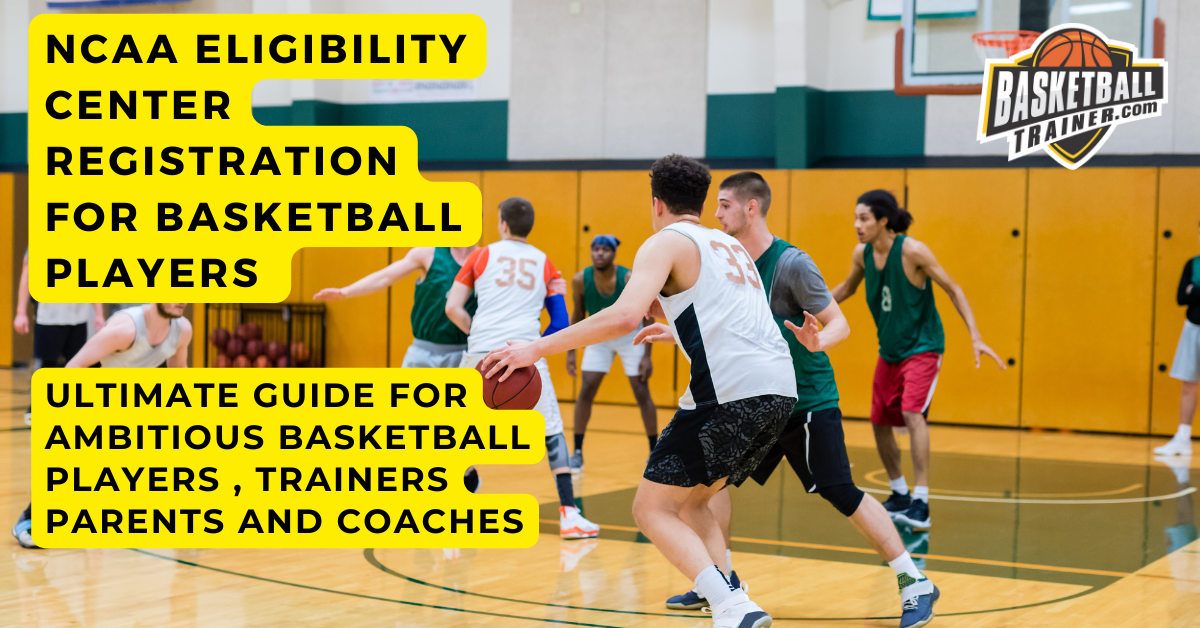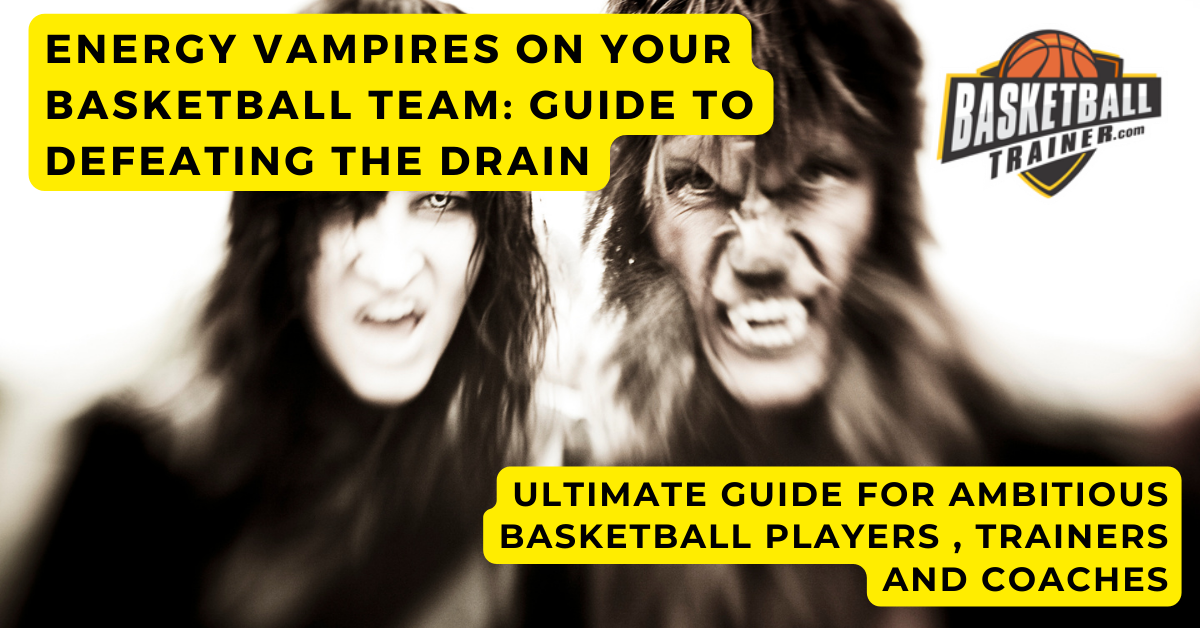
NCAA Basketball Eligibility Registration Center Guide is the roadmap to your dream of playing college basketball.
Though the journey may be challenging, it is certainly attainable.
This guide demystifies the complex process and helps you navigate through NCAA eligibility requirements. This guide provides a way to guarantee that athletes like you are ready for this critical part of your sports career.
In fact, understanding the NCAA Basketball Eligibility Registration Guide can be what separates an amateur player from a collegiate athlete. Without mastering these steps, reaching your full potential on court might remain just a dream.
Table of Contents:
- Decoding NCAA Eligibility Requirements
- Academic Standards
- Amateurism Rules
- Embarking on NCAA Eligibility Center Registration
- Submit Transcripts and Test Scores
- NCAA Eligibility: Receiving Your Certification Decision
- How to Sustain Your NCAA Eligibility Status
- Decoding NCAA Basketball Eligibility Registration by Division
- Resources for NCAA Basketball Eligibility Registration
- FAQs in Relation to Ncaa Basketball Eligibility Registration Guide
- Conclusion
Decoding NCAA Eligibility Requirements
To be an NCAA athlete, it is necessary to understand the eligibility criteria that guarantee academic and athletic standards are met. It demands a deep understanding of eligibility requirements, which ensure that all athletes uphold academic and athletic integrity.
Navigating through NCAA Eligibility Center Process
The NCAA Eligibility Center holds the key to your eligibility status. This involves examining high school transcripts, sports participation history, and compliance with amateurism rules. The first step in this journey requires setting up a certification account.
To kickstart the registration process, you need certain crucial information like a valid email address, details about core courses completed during junior year and senior year, as well as any relevant athletic participation records from previous years.
Paid Certification Account or NCAA Fees Waived?
A fee accompanies when creating an NCAA certification account, but under specific circumstances such as financial hardship or if hailing from regions including American Samoa among others, these fees may be waived by schools affiliated with either NCAA DI or DII via their respective compliance offices on a case-by-case basis.
Tackling Time Commitment: Understanding 10-50+ Hours Requirement
Becoming certified can consume time – ranging between 10-50 hours depending upon individual cases influenced by factors such as the complexity of academics and athletics background. Hence, it’s paramount not only to choose but also to adhere strictly to follow NCAA amateurism rules throughout this period so it doesn’t impact your eligibility center process negatively.
Academic Standards
The NCAA has put in place stringent academic requirements for student-athletes to guarantee they can meet the educational expectations of college while also playing sports. These standards are designed to ensure that players can handle the academic demands of college while also participating in sports.
Core Courses and Their Importance
To become eligible, the NCAA requires completion of specific core courses. For Division I athletes, this includes four years of English, three years each of math and natural/physical science, two years of social science, and one additional year from either English, math, science, or foreign language/non-doctoral religion/philosophy.
In contrast, DII core course criteria include three years each of English and Math, along with two-year stints in Natural Science or Social Sciences. Three additional classes must be completed within these subjects or in the area of Foreign Language / Non-doctoral Religion / Philosophy.
GPA Requirements: A Balancing Act
A minimum Grade Point Average (GPA) is necessary across all core courses to meet eligibility guidelines. This GPA requirement varies depending on your SAT score – it’s part of what’s known as the NCAA Sliding Scale principle at work here.
SAT & ACT Scores Matter Too.
Your standardized test scores also play a significant role in determining eligibility – hence why it’s called a sliding scale by experts. The higher your GPA, the lower SAT scores you’ll need later on during the evaluation stages to achieve eligible player status under the current rules established by the NCAA.
Maintaining Academic Progress Throughout College Years
- Degree Completion Milestones: Once enrolled at an institution following NCAA DI regulations, you have specific degree milestones to achieve – students should complete 40% of their degree by the end of sophomore year, 60% by junior year, and 80% by senior year.
- Satisfactory Term-Time Progress: To maintain satisfactory progress during term time, which typically means passing six hours per semester equivalent according to most colleges’ grading policies.
Key Takeaway:
Meeting NCAA eligibility isn’t just about athletic prowess, it’s a balance of academics too. You’ll need to complete specific core courses and maintain a minimum GPA that aligns with your SAT scores – this is the sliding scale principle. Don’t forget those degree milestones throughout college.
Amateurism Rules
The NCAA maintains stringent rules regarding amateurism, designed to uphold the integrity of college sports. The NCAA’s regulations guarantee that student-athletes do not gain financially from their involvement in sports.
NCAA Amateurism Regulations Explained
To be eligible for NCAA basketball, it’s crucial to follow NCAA amateurism rules. This implies athletes cannot receive payment or gifts in exchange for their performance on the court. Infringing these guidelines can lead to loss of eligibility and other penalties.
Athletes are also discouraged from signing contracts with professional teams or receiving benefits from agents before enrolling at a university.
Declaration Process – A Step Towards Compliance
In order to confirm compliance with these regulations, aspiring student-athletes must complete an amateur certification process through the NCAA Eligibility Center.
- This involves providing details about your sports participation history since ninth grade, including any monetary compensation related directly or indirectly to playing basketball.
- Your involvement in promotional activities.
- Your interactions with professionals such as agents or sponsors.
It’s imperative that all information provided is accurate and truthful.
Maintaining Your Amateur Status Post-Certification
If you’re certified by the NCAA Eligibility Center as an amateur athlete, remember this isn’t where your journey ends. It’s important that players continue adhering strictly to these guidelines throughout their entire collegiate career – even during summer breaks when they may participate in non-collegiate competitions.
Any changes post initial certification, such as being approached by a sponsor, should be reported immediately so your status can be reassessed without jeopardizing future eligibility opportunities within NCAA DI & DII levels.
Embarking on NCAA Eligibility Center Registration
The journey to becoming an eligible collegiate athlete begins with the crucial step of registering at the NCAA Eligibility Center. This intricate process requires a valid email address and detailed personal information and can take anywhere from 10-50+ hours. It involves meticulously documenting your academic eligibility history as well as your athletic participation.
Navigating through NCAA Clearinghouse Registration Fee
A mandatory part of creating a certification account in the eligibility center is paying a registration fee. The cost varies depending on whether you are applying for Division I (NCAA DI) or II athletics. Interestingly enough, if certain criteria, such as being from American Samoa or other U.S. territories, are met, your NCAA fees may be waived.
Sports Participation History: A Vital Element
- You will need to provide detailed information about your sports participation history starting from ninth grade (freshman year). This includes all teams you have been associated with during high school.
- Contact details of coaches, along with any awards received, also form an integral part of this section.
- This data serves not only for verification but also paints a comprehensive picture of your commitment to your sport over time.
Note:
While typically taking between 2-3 hours, the duration might extend depending on how much detail needs to be included in the sports participation segment.
Laying Down Your Academic Credentials
- In addition to submitting athletic data, applicants must ensure the submission of their high school transcripts directly through their schools.
- Your transcripts should include all core courses taken throughout junior year, as well as planned coursework for senior year.
Submit Transcripts and Test Scores
In the journey to NCAA eligibility, submitting your high school transcripts and test scores is a critical step. These documents are vital in establishing your academic qualifications for athletic participation at an NCAA DI or DII institution.
The Importance of High School Transcripts
Your high school transcripts offer insight into all core courses completed during both junior year and senior year. The NCAA’s list of approved core courses can be used as a reference point to ensure you’re academically aligned with requirements.
To facilitate this process, reach out to your guidance counselor or registrar who will forward these crucial records directly to the NCAA Eligibility Center. It’s essential that you initiate this early enough so as not to encounter any processing delays which could affect your certification account status.
Navigating Standardized Test Scores Submission
Beyond just providing evidence of coursework completion through transcripts, prospective student-athletes must also submit their SAT or ACT standardized test scores. This provides another layer confirming readiness for college-level workloads.
You’ll need specific codes (9999 for SATs; 9876 for ACTs) when registering for these tests ensuring they get sent straight from testing agencies rather than being submitted by students themselves—a detail worth noting while going through the registration fee payments phase within the NCAA Eligibility Center choose options.
Fees: A Necessary Consideration
Awareness about potential fees associated with sending official documents like transcripts and test scores is important—though some may find their NCAA fees waived under certain circumstances such as financial hardship scenarios. Always verify costs related to each organization before proceeding further into payment procedures linked with maintaining an active sports participation history on record throughout senior years leading up towards achieving desired basketball training ambitions.
Key Takeaway:
Key Takeaway: To secure NCAA eligibility, submit your high school transcripts and standardized test scores promptly. Use approved core courses as a guide for academic alignment, and remember to use specific codes when registering for tests. Be aware of associated fees, but know waivers may be available in cases of financial hardship.
NCAA Eligibility: Receiving Your Certification Decision
Upon the completion of your NCAA eligibility center process, you will be awaiting a crucial certification decision. The outcome of this procedure will decide if you can take part in college sports, depending on the academic record, previous athletic involvement and high school transcripts submitted during sign-up.
The Role of The NCAA Clearinghouse In the Review Process
This body evaluates all documents provided as part of this phase. They assess core courses taken throughout high school along with SAT or ACT scores to determine academic eligibility. A comprehensive analysis of athletic participation is also conducted against established guidelines set forth by the NCAA Eligibility Center guidelines.
Status Notification From The Certification Account
Your paid certification account-associated email address serves as an important communication channel here. All updates regarding decisions made about players’ statuses are sent via these valid emails, so it’s critical that they’re checked regularly. These notifications can indicate whether athletes have been certified (eligible), not certified (ineligible), or deemed “final academic and amateurism”. Players under the final category must wait until their senior year coursework has been completed and graduation date verified before receiving final clearance.
Potential Outcomes After Evaluation
- Certified players can play sports immediately upon enrollment at any participating NCAA DI institution.
- Non-certified individuals might need to meet specific requirements before regaining eligibility.
- Maintaining initial cleared status requires ongoing adherence to regulations defined by respective divisions within regions, including American Samoa among others.
How to Sustain Your NCAA Eligibility Status
The journey of a college athlete does not end with obtaining the NCAA eligibility status. In fact, that’s just the beginning. The real challenge lies in maintaining this status throughout your academic and athletic career at an NCAA member institution.
Navigating Academic Standards for Continued Eligibility
Academic performance plays a significant role in sustaining your NCAA eligibility. This includes meeting GPA requirements and completing core courses every year according to the standards set by the NCAA academic guidelines.
- Maintain regular communication with school advisors or athletic department representatives about any changes in academic criteria.
- Avoid falling behind academically; remember different divisions may have varying standards for continued eligibility.
- If you encounter challenges, seek help early from tutors or study groups within your university community.
Fulfilling Athletic Participation Obligations & Amateurism Rules
Besides academics, athletes must also adhere strictly to amateurism rules laid down by the NCAA, which include prohibitions against receiving payment for sports participation among other things. Any violation can put their certification account at risk, jeopardizing their future prospects of playing collegiate level basketball. So always be aware of what constitutes an infraction.
- In case of doubt, consult coaches or compliance officers before making decisions related directly or indirectly to athletic participation.
Tackling Unforeseen Circumstances Impacting Eligibility Maintenance
Decoding NCAA Basketball Eligibility Registration by Division
NCAA basketball eligibility registration is a multi-faceted process that varies significantly across divisions. This article aims to give aspiring players and their families a thorough guide on how to go through this essential step in achieving their goals.
The Rigors of DI and DII Regulations
In the realm of NCAA DI and DII regulations, aspiring athletes face stringent requirements, including 16 core courses throughout high school with specific subjects such as English, math, science, among others. These academic standards are essential components alongside sports participation history, which should be meticulously documented over your high school career.
DIII: A Different Ball Game
Contrastingly, DIII regulations do not necessitate a certification account with the NCAA Eligibility Center. Instead, they entrust admission criteria directly into the hands of prospective colleges, thereby emphasizing direct communication regarding athletic opportunities and academic eligibility expectations.
Certification Process: Your Key To The Court
To kick-start your journey in either DI or DII, you need to set up a paid certification account at the NCAA Basketball Eligibility Registration Center using a valid email address. After successful payment, unless NCAA fees are waived due to financial hardship, it’s time to submit all necessary documents like transcripts, preferably by junior year but no later than senior year, along with SAT/ACT scores if applicable.
The review process usually requires around 2-3 hours post-submission, after which you will receive a decision about your status.
Remember. Every player’s dream includes American Samoa, Puerto Rico, etc. – just like mainland US students who follow the same rules, making them eligible for playing college-level sports. Stay informed.
Resources for NCAA Basketball Eligibility Registration
Let’s explore some of these key tools and platforms.
NCAA Eligibility Center Website: Your Primary Guide
NCAA Eligibility Center website, the hub of all things related to eligibility, is your go-to resource. It provides a comprehensive guide on rules and regulations about the NCAA eligibility center process, as well as instructions on how to submit necessary documents such as high school transcripts or sports participation history.
Fees Waiver Guide: Ensuring Equal Opportunities
If the registration fee becomes a barrier, don’t worry. The Fees Waiver Guide provided by the NCAA outlines scenarios where NCAA fees could potentially be waived, ensuring every aspiring athlete has equal opportunities regardless of their financial situation.
NCAA Division I Manual: Comprehensive Details About Requirements
To gain insights into the specific demands of playing at the highest level – NCAA DI, which requires a significant commitment (10-50+ hours per week), reviewing the NCAA Division I Manual would prove beneficial. NCAA Basketball Eligibility Registration Center manual includes exhaustive details regarding core courses required during the junior year and senior year, among other essential guidelines.
Local Support From Athletic Counselors & Coaches
Your journey towards meeting NCAA eligibility doesn’t have to be a solitary one. High school athletic counselors or coaches might offer invaluable advice based on their experience assisting previous students who successfully navigated this process. They may share tips tailored specifically to your unique circumstances, including maintaining amateurism status following NCAA amateurism rules.
FAQs in Relation to Ncaa Basketball Eligibility Registration Guide
How do you determine NCAA eligibility?
NCAA eligibility is determined by meeting academic standards, adhering to amateurism rules, and registering with the NCAA Eligibility Center.
When should I register with the NCAA Basketball Eligibility Registration Center
You should ideally register with the NCAA Eligibility Center at the start of your junior year in high school.
How many years of NCAA eligibility do I have?
In general, you get five calendar years to play four seasons of competition once enrolled in a college full-time.
How much does it cost to create an NCAA eligibility account?
The fee for U.S. students is $90 while international students pay $150 to create an account on the NCAA Eligibility Center.
Conclusion
Navigating the NCAA Basketball Eligibility Registration process can seem like a daunting task.
But, with our guide, you’ve taken an important step towards understanding and meeting the requirements for college basketball eligibility.
You’ve learned about academic standards that must be met and how amateurism rules apply to your journey.
The importance of registering with the NCAA Eligibility Center is now clear in your mind.
You understand that submitting transcripts and test scores are crucial parts of this process.
And finally, receiving a certification decision from the center will set you on track for maintaining your status throughout college.
Let’s get started on the path to achieving your goals! At BasketballTrainer.com, we’re here to help ambitious players like you connect with expert trainers, teams, camps, and resources needed for success on the court.
Join us now and make those aspirations a reality!








